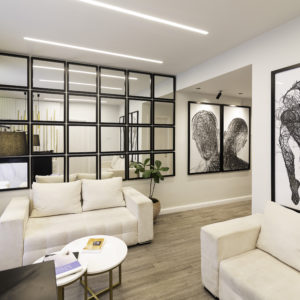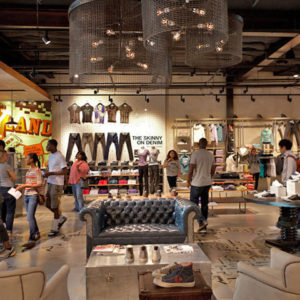


At the end of 2012, printing office Drukta and mailing company Formail moved into their new building. Not a new build, but a former textile company’s warehouse, spanning 4.000 sqm. For their office space, both companies were looking for a solution which needed to fit their needs and budget. At the same time, they really wanted the original and creative concept to become a proper eye-catcher, linking the office area with the machines on the workfloor – a task right up the street of interior designers Five AM in Kortrijk (Belgium).

Experience and transparency
At the beginning of February, Drukta and Formail approached Five AM with the request to come up with an original solution to fit their office space in the warehouse. Drukta aimed to step away from the classic image of a printing office, where there is hardly any room for image building. Both owners wanted a concept pivoting around ‘experiences’, so that clients leave with a lasting memory after their visit. For Formail, the link between the atelier/machines and offices prevailed.

Silo mentality had to make way for optimal transparency of all of the company’s activities. During their quest for a partner for this project, the design Five AM presented some time before for the Liebaert Projects art centre, immediately caught their attention, more precisely the shipping containers which were assembled track-wise in the large space. This idea of integrating the office space in shipping containers or some other kind of units, seemed the perfect solution for the 4000 sqm warehouse.

Upcyling
Also from a sustainability point of view, both partners subscribed to the philosophy of recycling and re-using second hand containers. The choice for Upcycling was an easy one. Rather than building a brand new construction in the warehouse, upcycling allowed for existing materials to be applied in a sustainable way. Moreover, the flexible and modular character of the containers opened a wealth of options – so deciding on the basic material was not hard.

From then on, Five AM could start on designing the actual set-up, the interior design, the finishing and… choosing what kind of containers they would use. The containers were chosen by hand and in person in the port of Antwerp, before being put together in a test assembly. This way, the duo could experience what kind of set-up would support the best the relation with the existing building and the atelier. The clients were really looking for more than just a creative, original and appealing design. Just as important was the link with the total concept. This unusual take on office space design had to be translated towards both companies’ activities. Five AM also included visibility, transparency and approach-ability, by using big windows and steel staircases up to the offices.

From container to office
After all the plans were finalised, all shipping containers were adjusted to their new life as office space. Openings for doors, windows and passages were cut. Interior walls were erected. The outside was painted in contrasting colours to the concrete of the workfloor (black for Drukta, yellow and black for Formail). And last but not least, they made their way to Kortrijk on trailers, to be assembled in their final positions (see http://vimeo.com/48512591# ).

However, they were not placed in their entirety inside the building; part of them is visible from the outside still. The Drukta entrance for instance sticks almost 0.5 m out of the building, and for Formail the old loading docks were used. The main advantages of this set-up are the fact that natural light can flow into the offices and that the containers add cachet to the exterior of the building.

Simplicity does it
For the finishing of the containers, Five AM opted for a sober but attractive style, to go with the preferences of both building partners. For the cladding for instance, building materials were used. For the interior walls in the Drukta offices, the use of multiplex created a warm and cosy feel, further enhanced by the carpet on the floor. At Formail, they went for a bit more minimalistic style, with MDF panels painted white. Also functionality was important, since the containers were partly outside and had to be insulated.

Five AM kept the lighting sober: rhythmically placed TL lights in the offices and indirect lighting in the toilets. Apart from artificial lights, in the Formail offices especially a lot of thought went into having as much natural light flowing in as possible, with big windows in the containers and in the façade, but also by placing a long skylight in the area for manual handling. And this is how bold containers were transformed into bright and airy offices and pleasant working spaces.

Re-usable concept
Assembling shipping containers into larger constructions and fitting these into existing buildings, is not a new idea for fast and durable building concepts. However, Five AM delivers added originality, which is of course applicable to other companies. With their choice of materials and clever use of space, the design duo succeeded to obtain the result the clients wanted, while still being on a smaller budget. Also, the modular characteristics guaranteed flexibility, taking away the need for any drastic work, since at any time extra containers can be added or the existing containers can be moved to another location. What is certain, is that both Drukta and Formail are very happy with the result – and moving is not on the immediate agenda.



















